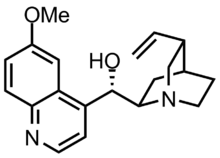Quinidine
 | |
| Clinical data | |
|---|---|
| Trade names | Quinaglute, Quinidex |
| Other names | (2-Ethenyl-4-azabicyclo[2.2.2]oct-5-yl)-(6-methoxyquinolin-4-yl)-methanol |
| AHFS/Drugs.com | Monograph |
| Pregnancy category |
|
| Routes of administration | By mouth, intramuscular injection, intravenous |
| ATC code | |
| Legal status | |
| Legal status | |
| Pharmacokinetic data | |
| Bioavailability | 70–85% |
| Metabolism | 50–90% (by liver) |
| Elimination half-life | 6–8 hours |
| Excretion | By the liver (20% as unchanged quinidine via urine) |
| Identifiers | |
| |
JSmol) | |
| |
| |
| | |
Quinidine is a
Medical uses
Quinidine is occasionally used as a
It reduces the recurrence of atrial fibrillation after patients undergo cardioversion, but it has proarrhythmic effects and trials suggest that it may lead to an overall increased mortality in these patients.[5]
Quinidine is also used to treat short QT syndrome.[6]
Eli Lilly has discontinued manufacture of parenteral quinidine gluconate in the US, and its future availability in many countries is uncertain.[7]
Other uses
There is one study supporting the use of a novel combination of
Although intravenous quinidine is sometimes used to treat Plasmodium falciparum malaria, the future availability of this agent is uncertain.[10]
Side effects
Quinidine is an inhibitor of the
Quinidine can cause thrombocytopenia, granulomatous hepatitis, myasthenia gravis, and torsades de pointes (dangerous heart rhythm),[12] and has been largely phased out in favor of other antiarrhythmics. Torsades can occur after the first dose. Quinidine-induced thrombocytopenia (low platelet count) is mediated by the immune system, and may lead to thrombocytic purpura.
Quinidine intoxication can lead to a collection of symptoms collectively known as cinchonism, with tinnitus (ringing in the ears) being among the most characteristic and common symptoms of this toxicity syndrome.
Pharmacology
Pharmacodynamics
Quinidine acts as a
Mechanism of action
Like all other class I antiarrhythmic agents, quinidine primarily works by blocking the fast inward sodium current (INa). Quinidine's effect on INa is known as a 'use dependent block'. This means at higher heart rates, the block increases, while at lower heart rates, the block decreases. The effect of blocking the fast inward sodium current causes the phase 0 depolarization of the cardiac action potential to decrease (decreased Vmax). It seems still efficacious as an IV antimalarial against Plasmodium falciparum. This electrolyte dependent agent also increases action potentials and prolongs the QT interval. Quinidine also blocks the slowly inactivating,
At micromolar concentrations, quinidine inhibits
The effect of quinidine on the ion channels is to prolong the cardiac action potential, thereby prolonging the QT interval on the surface ECG.
Other ECG effects include a wide notched P wave, wide QRS complex, depressed ST segment, and U waves. These are the results of both slowed depolarization and repolarization.
Pharmacokinetics
Elimination
The
History
The effects of cinchona bark (the botanical source from which quinidine is extracted) had been commented on long before the understanding of cardiac physiology arose. Jean-Baptiste de Sénac, in his 1749 work on the anatomy, function, and diseases of the heart, had this to say:
"Long and rebellious palpitations have ceded to this
febrifuge".[19]
"Of all the stomachic remedies, the one whose effects have appeared to me the most constant and the most prompt in many cases is quinquina [Peruvian bark] mixed with a little rhubarb."[20]
Sénac subsequently became physician to Louis XV of France, a counselor of the state, and superintendent of the mineral waters and medicinals in France. As a result of his influence, throughout the 19th century, quinine was used to augment digitalis therapy. It was described as das Opium des Herzens (the opium of the heart).
However, the use of quinidine to treat arrhythmia really only came into its own because a physician listened to the astute observation of one of his patients. In 1912, Karel Frederik Wenckebach saw a man with atrial fibrillation. He was a Dutch merchant, used to good order in his affairs. He would like to have good order in his heart business, also, and asked, "why there were heart specialists if they could not abolish this very disagreeable phenomenon ... he knew himself how to get rid of his attacks. As I did not believe him, he promised to come back next morning with a regular pulse, and he did."
The man had found by chance that when he took one gram of quinine during an attack, it reliably halted it in 25 minutes; otherwise it would last for two to 14 days. Wenckebach often tried quinine again, but he succeeded in only one other patient.[19]
He made passing mention of it in his book on cardiac arrhythmias published in 1914. Four years later, Walter von Frey of Berlin reported in a leading Viennese medical journal that quinidine was the most effective of the four principal cinchona alkaloids in controlling atrial arrhythmias.[21]
Chemistry
Quinidine-based ligands are used in AD-mix-β for Sharpless asymmetric dihydroxylation.
Veterinary use
Quinidine sulfate is used in the treatment of atrial fibrillation in horses.[22][23]
References
- ^ PMID 9414330.
- PMID 32110303.
- ^ "Artesunate Now First-Line Treatment for Severe Malaria in the United States". CDC Online Newsroom. U.S. Centers for Disease Control and Prevention. 28 March 2019. Retrieved 6 April 2019.
- PMID 28685701.
- PMID 31483500.
- S2CID 42247356.
- ^ "Quinidine Gluconate Injection". FDA: Drug Shortages. U.S. Food and Drug Administration. 1 December 2017. Archived from the original on 22 March 2019.
- PMID 29637593.
- S2CID 25732335.
- ^ "Quinidine Availability in the United States". U.S. Centers for Disease Control and Prevention. 2019-01-28.
- S2CID 38467170.
- ISBN 978-0-912912-06-6.
- PMID 25927480.
- ISBN 978-0-323-32641-4.
- ^ ISBN 978-1-4377-1679-5.
- ISBN 978-3-527-67367-4.
- ISBN 978-1-4615-1303-2.
- PMID 9570190.
- ^ PMID 1747282.
- PMID 15227324.
- ISBN 978-0-471-89980-8.
- .
- PMID 25829865.
